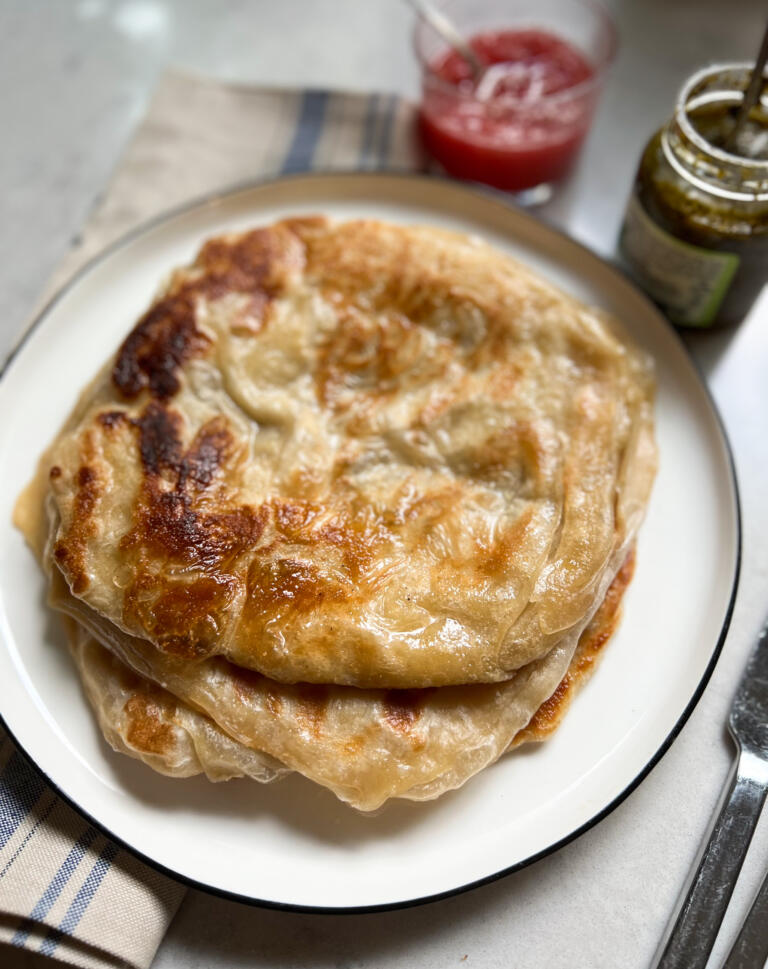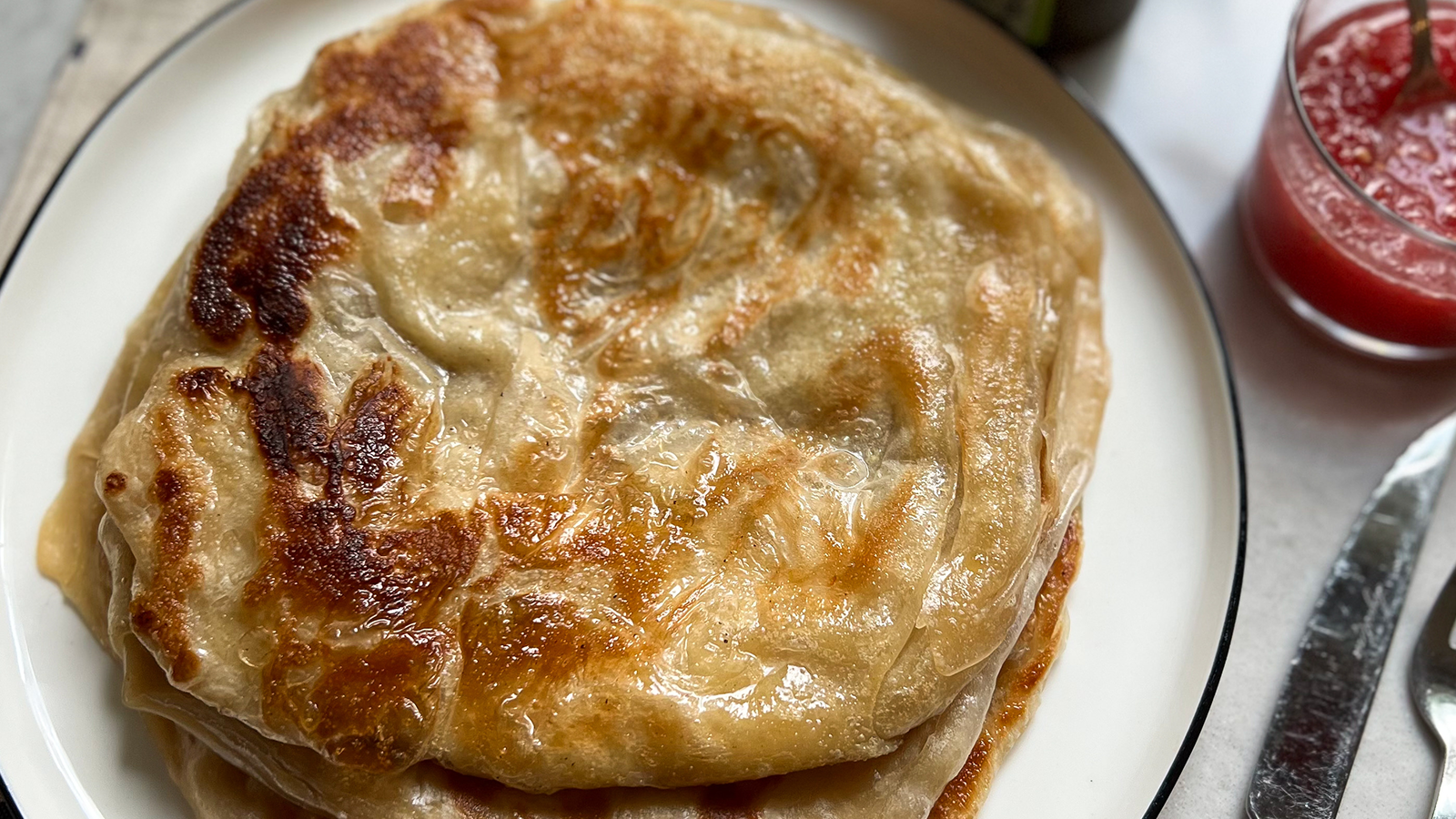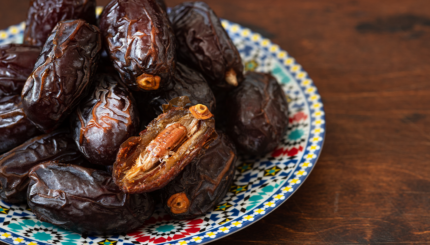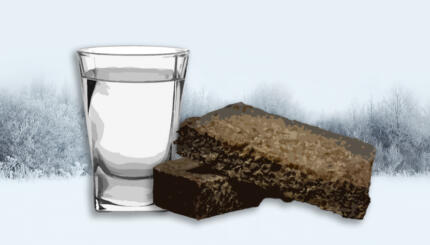Jachnun is not the only Yemenite pastry to become a household item in Israeli cuisine.
Malawach, its popular cousin, is up there too. Both are made with the same dough, stretched and spread with samneh. But unlike jachnun, which is rolled into a cylinder and slow-cooked overnight, malawach is served like a flat bread, and is either fried in a skillet or baked in a taboon, a clay oven that Yemenites used to have in their yards — some even do until today.
Malawach, or khubz mulawah, is still popular in Yemen, and similar recipes are available around the Arab world, like Khobz al tawa (griddle bread), Iraqi kahi and Moroccan meloui or malawi. The Muslim Yemenite mulawah is sprinkled with nigella seeds. Adenite Jews used to serve it with sugar, but it’s more common to see it next to tomato sauce, zhug, overnight hard-boiled eggs, and sometimes even with tahini sauce and pickles.
These days, both jachnun and malawach are available in the freezer aisle at any supermarket in Israel, offering an inferior but easy option for those daunted by the labor-intense process of making the dishes at home.
The Nosher celebrates the traditions and recipes that have brought Jews together for centuries. Donate today to keep The Nosher's stories and recipes accessible to all.
This dough recipe is very similar to that of the jachnun. You can just double the jachnun recipe and make malawach with it, or follow this version (which I prefer), instead.
While malawach is not a very hands-on recipe, it does take a while to make, as the dough needs to rest four times: twice for one hour, then for three to four hours and finally for another three hours or in the refrigerator overnight. If you opt to rest it overnight, you will need to let it sit at room temperature the following morning for two hours before you fry it.
After completing Direction 6, you can freeze some of the malawach for later use. Put them in a freezer bag, separated with parchment paper or plastic wrap and freeze. When you’re ready to fry the malawach, you can take them straight from the freezer, no need to thaw.

Yemenite Malawach
This Yemenite multi-layered flat bread is very popular in Israel, where it’s served with grated tomato sauce, zhug, overnight slow-cooked eggs, and sometimes tahini and pickles.
- Total Time: 9 hours 10 minutes
- Yield: 10
Ingredients
- 2 lb all-purpose flour
- 5 Tbsp light brown sugar
- 3 ½ tsp kosher salt
- 2 ¼–2 ½ cups lukewarm water
- ¼ cup vegetable or corn oil
- 8 Tbsp melted butter, clarified butter (ghee) or more oil
- 3 Tbsp butter, for frying
- spicy tomato salsa, to serve
Instructions
- Put flour, sugar and salt in the bowl of a stand mixer fitted with the dough hook and mix a little with a spoon. Turn the mixer on medium-low and add 2¼ cups water, then knead for 5 minutes. If It seems too dry, add 1 Tbsp water at a time, until the dough is soft.
- Remove bowl from mixer, cover bowl with plastic wrap and let rest for 1 hour. After 1 hour, knead again for 5 minutes. Let the dough rest again for another hour, covered with plastic wrap.
- Put ¼ cup oil in a small bowl. Divide the dough into two, roll each half to a 2-inch-thick log and cut into five equal pieces (for a total of 10 pieces.) Roll each piece into a ball, dip in the oil to cover, and let rest on a rimmed baking sheet. Cover dough balls tightly with plastic wrap and let rest for 3-4 hours. Resting will make stretching the dough easier.
- Use a rolling pin to roll the first ball into about a 10-inch circle. Using your hands, stretch the dough further into a very thin 15-inch circle. Do it slowly by lifting the sides of the dough and stretching again and again until you can almost see the countertop through the dough.
- Using your hand or a pastry brush, spread about 2 tsp of the butter all over the dough. Fold the left third of the circle inside, and then fold the right third on top, like an envelope, to make a long rectangle. Fold the bottom quarter up and the top quarter down, and then fold them on top of each other into a small square. Put back on the baking sheet. Repeat with the rest of the dough. Cover with plastic wrap and let rest for another 3 hours. (You can also let dough rest in the fridge overnight, but take it out of the fridge at least two hours before you are ready to continue.)
- Use a rolling pin to gently roll each square into a thin 9-inch round. Pile the rolled malawach on a plate, separating them with parchment paper or plastic wrap.
- Put a large nonstick pan over medium heat. Add ½ Tbsp butter and fry malawach, one at a time, until golden brown on both sides, about 4 minutes total. Don’t let the malawach brown too quickly, if it does just reduce the heat. Repeat with the rest of the malawach.
- Serve hot with a side of spicy tomato salsa.
- Prep Time: 30 minutes + 8 hours resting time
- Cook Time: 40 minutes
- Category: Side Dish
- Method: Baking
- Cuisine: Vegetarian




Definitely good and well worth the effort. All day flatbread may sound like too long for some people. I make Old World breads and that takes 3 raisings with a total time of 5 – 6 hours. What’s a few more hours for home made flat breads. It tastes 100% better than the Lavash I buy at the store.
Why the need to “rise’? The dough does not contain yeast, so what’s to rise?
This recipe seems just like any regular flat bread.
I made this and it was truly delicious and so flaky!! Especially dipped into freshly grated tomato’s. It took me back to my childhood. I’m making this recipe again today and I follow the video you made on Instagram, it’s very helpful!! Thank you
To Reb, who asked why an unleavened bread needs to “rise” for so long. My handy browser AI gave me the answer to the query “why does malawach need to rise?” (Of course Artificial Intelligence plagiarizes answers from copyrighted online content but at least often lists the source material).
In the case of unleavened bread, it’s not actually rising since, as Reb said, there’s no yeast or other fermentation; but it is RESTING, and that’s for several great reasons!
* Relaxation of gluten: laminated (rolled and folded) dough contains gluten strands that need time to relax and unwind, making the dough easier to roll and fold, in turn helping create the desired flaky layers.
* Fat distribution: The dough contains butter or other fats needing time to diffuse, or distribute through the dough, giving a consistent flaky texture throughout the finished product.
* Hydration: Malawach dough often uses a relatively low water content. Resting helps the dough absorb that small amount of water evenly, ensuring a tender crumb.
* Development of layers: Folding and rolling creates layers within the dough, and resting allows the layers to set and become more defined, contributing to the characteristic flakiness of malawach.
* Improved laminating: Resting enables the dough to become more pliable, making it easier to laminate (fold and roll) without tearing or breaking. This results in a more even distribution of fat and a more delicate, flaky texture.
So there you go!